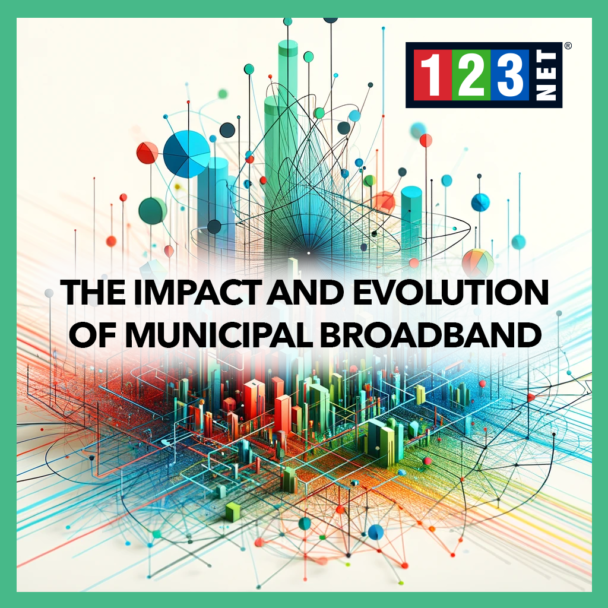
Introduction
Municipal broadband represents an increasingly vital part of the digital landscape, empowering communities with locally owned and operated high-speed internet services. As the digital divide widens, municipal broadband has emerged as a pivotal solution for fostering digital equity and accessibility. In the modern era, where internet access is akin to a utility, such as water or electricity, the importance of these community networks cannot be overstressed. This article explores the definition, evolution, and significance of municipal broadband, examining its benefits, challenges, and technological aspects, alongside its economic and community impacts.
Definition and History of Municipal Broadband
Definition and Service Model
Municipal broadband encompasses internet services provided either by local governments or via their partnerships with private entities. This model is primarily targeted at fostering network infrastructure in regions typically underserved by mainstream ISPs. It is designed not just to compete with existing providers but to fill significant service voids, ensuring that every community member has reliable access to high-speed internet.
Historical Roots and Development
The concept of municipal broadband originated from small, localized efforts that sought to provide crucial internet access in areas overlooked by commercial ISPs. Initially modest in scope, these initiatives frequently started as grassroots movements driven by community leaders and local governments passionate about digital inclusion. Their aim was straightforward yet ambitious: to transform the digital landscape of their communities.
Evolution into Advanced Networks
As these projects gained momentum and broader acceptance, they evolved significantly. What began as simple setups to offer basic internet services gradually transformed into sophisticated, fiber-optic networks capable of supporting massive data transfer speeds and connecting entire cities. This evolution has been critical in reshaping telecommunications policies at local levels, setting precedents for community-driven network management and infrastructure development.
This growth reflects a broader trend towards enhancing network technology and telecommunications policy, driven by an understanding of the internet as a fundamental service necessary for the socio-economic development of any community. Through these advancements, municipal broadband has become a powerful tool for ensuring broad, equitable access to the digital world, challenging traditional ISPs and reshaping the future of local internet services.
The Case for Municipal Broadband
Enhanced Connectivity and Digital Inclusion
The argument in favor of municipal broadband centers on its capacity to provide faster internet speeds, reduce costs, and extend broader access across communities. By deploying municipally managed networks, local governments can offer residents high-speed internet at competitive prices, often undercutting the rates of private providers. This not only boosts local ISPs by introducing healthy competition but also significantly enhances digital inclusion. Access to reliable and affordable high-speed internet is a crucial factor in bridging the digital divide, enabling equal opportunities for education, business, and personal growth.
Chattanooga: A Model for Digital Equity
A prime example of municipal broadband’s potential is seen in Chattanooga, Tennessee. The city’s investment in a fiber-optic network transformed it into one of the first in the U.S. to offer gigabit internet speeds to all residents and businesses. This initiative not only bolstered the local economy but also established Chattanooga as a leading model of digital equity and community development. The network, known as “Gig City,” illustrates how municipal broadband can catalyze technological advancement and economic prosperity at the local level.
Broader Impacts and Case Studies
Further underscoring the benefits of municipal broadband are numerous case studies from cities across the United States. These examples highlight how municipal networks can level the playing field, offering high-speed internet where private ISPs have either failed to reach or chosen not to invest. By examining these success stories, it becomes clear that municipal broadband is not just a utility service but a foundational platform for future-proofing cities, fostering long-term growth, and ensuring that all citizens can participate in the digital age.
Challenges and Criticisms
Political and Legal Hurdles
While municipal broadband offers numerous benefits, it also encounters substantial challenges, particularly in the political and legal arenas. These networks frequently face opposition from well-established ISPs, which wield considerable influence in legislative circles. These companies view municipal broadband as a threat to their market dominance and respond by lobbying intensively against such projects. This opposition can manifest in the form of restrictive laws and regulations designed to stymie the development of community-owned networks.
Competition and Market Dynamics
The competition between municipal broadband initiatives and major ISPs is a critical aspect of the broader competitive landscape. Major ISPs often argue that municipal networks represent unfair competition because they can be subsidized by government resources, potentially leading to pricing and service disparities that private companies cannot match. This tension underscores the complex interplay between public initiatives aimed at increasing digital inclusivity and private interests. They are focused on maintaining profitability and shareholder value.
Regulatory and Policy Framework
The development of municipal broadband is heavily influenced by local, state, and federal regulations. This can either enable or restrict the expansion of these networks. In some states, laws are explicitly designed to make it difficult for municipalities to enter the broadband market. This is requiring them to navigate a labyrinth of bureaucratic hurdles before they can even begin to offer services. These legal and policy challenges affect the implementation and growth of municipal broadband.
Technological Aspects of Municipal Broadband
Core Infrastructure: Fiber Optics
The backbone of municipal broadband is its infrastructure, with fiber optics playing a pivotal role. Fiber-optic technology supports the high-speed, high-capacity data transmission that modern internet users require. Unlike traditional copper lines, fiber optics can transmit vast amounts of data over long distances without significant loss of signal quality. This capability is essential for delivering broadband services that are not only fast but also reliable and scalable. These are meeting the needs of today’s digital consumers and businesses.
Current Technological Frameworks
Municipal networks typically employ advanced network technologies that ensure both extensive coverage and robust performance. These technologies include but are not limit to, GPON (Gigabit Passive Optical Networks) and active Ethernet. It will provide the necessary infrastructure for delivering services such as high-speed internet, VoIP, and IPTV directly to end users. This section delves into how these frameworks form the core of municipal broadband systems. These are detailing their operation, benefits, and the role they play in managing network traffic effectively.
Future Innovations and Enhancements
Looking forward, there is significant potential for innovations that could further enhance the accessibility and capacity of municipal broadband. Emerging technologies like 5G wireless, software-defined networking (SDN), and network function virtualization (NFV) offer opportunities to augment traditional fiber-optic networks. These technologies promise to improve network management flexibility, reduce operational costs, and provide even faster service deployment times. By integrating such advancements, municipal broadband can continue to evolve. This is ensuring it remains competitive with private ISPs and continues to meet the growing demands of digital users. This section will explore potential future technologies that could revolutionize the way municipal networks operate and serve their communities.
Economic and Community Impact
Economic Growth and Job Creation
Municipal broadband initiatives are powerful economic catalysts. By providing high-speed internet access, these networks enable job creation and sustain economic growth within communities. The availability of robust internet services attracts businesses looking for reliable connectivity. This is a critical infrastructure need for today’s digital economy. Moreover, the construction, maintenance, and operation of municipal broadband infrastructure create jobs. These can be ranging from technical support to network management and administration. This influx of opportunities contributes to local economic vitality and stability.
Supporting Education and Healthcare
Beyond economic benefits, municipal broadband significantly impacts education and healthcare sectors. Schools with high-speed internet can offer students a more extensive array of online learning tools and resources. This can enhance educational outcomes and prepare students for a competitive, digital world. In healthcare, enhanced internet access enables telemedicine services. They are particularly vital in underserved or rural areas where medical facilities may be scarce. These services allow for remote consultations, patient monitoring, and access to specialists, improving community health outcomes and increasing the efficiency of healthcare delivery.




